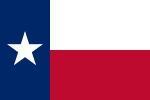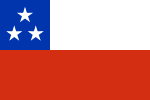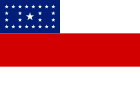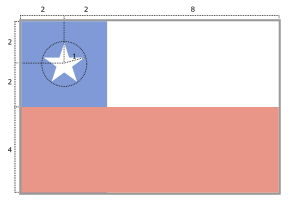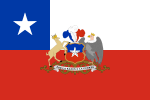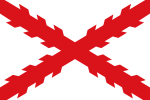- Flag of Chile
-
Flag of Chile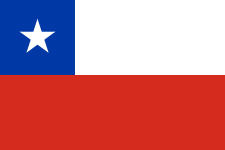
Use National flag and ensign 
Proportion 2:3 Adopted October 18, 1817 The national flag of Chile, consists of two unequal horizontal bands of white and red and a blue square the same height as the white band in the canton, which bears a white five-pointed star in the center. It was adopted on October 18, 1817. The Chilean flag is also known in Spanish as La Estrella Solitaria[1] (English: The Lone Star).
The star represents a guide to progress and honor; blue symbolizes the sky and the Pacific Ocean, white is for the snow-covered Andes, and red stands for the blood spilled to achieve independence.[2]
According to the epic poem La Araucana, the colors were derived from those from the flag flown by the Mapuche during the Arauco War. "Flag Day" is held each year on the ninth of July to commemorate the 77 soldiers who died in the 1882 Battle of La Concepción.
Contents
History
Pre-independence flags
The first records on the possible use of flags by indigenous peoples date back to the War of Arauco, the most famous being the use described in the late 16th century epic poem La Araucana. In Canto XXI, Alonso de Ercilla described Talcahuano, warrior and chief of the Mapuche who inhabited the lands near the present-day city that bears his name, bearing emblems of blue, white and red.
Two flags have been documented as used by Mapuche troops. However, these descriptions were made late in the eighteenth century without certainty about the age of them. One consisted of a five-pointed white star on a blue background similar to the canton of the current Chilean flag, while the second had a white eight-pointed star centered on a blue diamond with border zigzagged over a black background. The latter flag appears to be waved by the chief Lautaro in the best-known artistic representation of it, created by painter Peter Subercaseaux.[3]
In the case of the colonizing troops, they used several Spanish flags. Each battalion had its own flag, which could incorporate different elements including the heraldic coat of arms of the King of Spain. One of the symbols most commonly used was the Cross of Burgundy, a jagged, red saltire crossed on a white cloth. The Cross of Burgundy was one of the main symbols of the Spanish Empire overseas, so it flew over the warships and was carried by the militia in the colonial territory during the Spanish colonization of the Americas.
In 1785, Carlos III established a uniform flag for all ships of the Spanish Armada, similar to the current flag of Spain. The use of this red-and-yellow flag would be extended in 1793 to "maritime towns, castles and coastal defenses." Despite the establishment of this new flag, the cross of Burgundy would still often used by colonial entities.
Flag of the Patria Vieja (1812-1814)
 Flag of the Patria Vieja (1812-1814). First Chilean national flag. Simple version without shield, used by merchant ships.
Flag of the Patria Vieja (1812-1814). First Chilean national flag. Simple version without shield, used by merchant ships.
 Flag of Patria Vieja (1812-1814). Alternative version with the first Chilean shield, Cross of Santiago and reversed blue and white stripes.
Flag of Patria Vieja (1812-1814). Alternative version with the first Chilean shield, Cross of Santiago and reversed blue and white stripes.
At the onset of the Chilean War of Independence, the First Government Junta was proclaimed on September 18, 1810, marking Chile's first step toward independence. It would be during the government of Jose Miguel Carrera in which the desire for emancipation would gain more strength. Nevertheless, the junta was established (at least nominally) as a way of controlling the government during the absence of King Fernando VII, so that the symbols of government remained Hispanic. Therefore, one of the first acts of his government would be the implementation of national symbols, such as an insignia, a coat of arms and a distinctive flag to identify the patriots. The first flag, according to tradition, would have been embroidered by the sister of the ruler, Javiera Carrera, and would be presented and raised for the first time on July 4, 1812 at a dinner with the United States consul Joel Roberts Poinsett to celebrate the anniversary of U.S. independence, an event having a great influence on the locals' struggle for independence.
Named the flag of the Patria Vieja ("Old Fatherland"), the flag had three horizontal stripes of blue, white and yellow. For some, the bands represent the three branches of government: majesty popular, law and force, respectively; to others, the stripes represent features of nature: the sky, the snowy Andes and fields of golden wheat, respectively. The following September 30, during a celebration in the capital to commemorate the first government junta, the Chilean coat of arms, also called Patria Vieja, was solemnly adopted and included in the center of the flag.
Although the blue-white-yellow flag of the Patricia Vieja was the most recognized, other versions utilized a different arrangement of the colors, such as white-blue-yellow, for example. On other occasions, the red Cross of Santiago was included in the upper left corner together with the coat of arms in the center. The cross originates from the victory of the patriot troops in the Battle of El Roble, where within the possessions of the captured war booty was a distinctive insignia of the Order of St. James, an important symbol of Spanish pride.
In 1813 after the royalist invasion and the outbreak of the War of Independence, the Spanish symbols were abolished and the tricolor flag was formally adopted by the patriotic forces in a ceremony at the Plaza Mayor of Santiago. Months later in 1814, Carrera left political and military power, and Francisco de la Lastra was chosen as Supreme director. The war of independence began at great losses for the patriot side, and so signed Treaty of Lircay on May 3, 1814. This agreement reaffirmed the Spanish sovereignty over the territory of Chile, among other things, and as one of its direct consequences, the colonial flag was readopted at the expense of the tricolor.
The flag of the Patria Vieja would wave again after Carrera's return to power July 23, 1814 until the Battle of Rancagua (October 1–2) where the royalist victory ended the patriot government and began the Reconquista (or Reconquest) from 1814 to 1817, restoring the imperial standard. The tricolor flag was last flown for the last time in the Battle of the Papers (Batalla de los Papeles), but it would appear again raised in the ships that José Miguel Career brought in 1817 and during his campaigns in Argentina (1820–1821). The Reconquista ended with the victory of Liberation Army of the Andes (Ejército Liberatador de los Andes) in the Battle of Chacabuco on February 12, 1817. In this battle, the patriot troops fought with the army colonel and the flag of the Army of the Andes, inspired by the flag of Argentina, without readopting the blue-white-yellow standard.
Today, the flag of the Patria Vieja is used during celebrations for this Chilean historical period, conducted by the National Institute (Instituto Nacional General José Miguel Carrera), which Carrera's government founded (August 10, 1813). The emblem, adopted as a symbol at the beginning of careerism, was subsequently adopted by Chilean nationalism movement. For example, the flag with a red lightning bolt emblem superimposed was the insignia of the National Socialist Movement of Chile between 1932 and 1938.
Flag of the Transition (1817-1818)
The victory at the Battle of Chacabuco on May 26, 1817 gave way to a new period known as the Patria Nueva (New Fatherland). A new flag was adopted that day, known today as the Flag of the Transition (Bandera de la Transición), and it is recognized as the first national flag and the last flag used until the one used currently. It was widely publicized at the time that the design was attributed to Juan Gregorio de Las Heras. This flag had three equal stripes: blue, white, and red. The bottom red strip replaced the yellow from the flag of 1812. The origin of the flag's colors would be based on the description given by Alfonzo de Ercilla as those of the insignia of the Mapuche troops. The significances of these colors were equivalent to those of the Patria Vieja, except that the yellow replaced the red to represent the blood shed during the many conflicts.
Despite initial enthusiasm, this flag did not obtain official legalization and disappeared five months later. One reason for its suppression was that it was easily confused with the flag of the Netherlands or the tricolor of revolutionary France, from which it was inspired. According to the General History of Chile by Diego Barros Arana, the last time the Flag of the Transition was unfurled was at the ceremony to commemorate the Battle of Rancagua, two weeks before the adoption of the current national flag. However, there is information about a possible third flag between the Transitional and final, which would have exchanged the order of white and blue stripes and incorporated the five-pointed white star on the central strip, but there is no certainty of this, and it is not accepted by the majority of Chilean historians.
Third and current flag
The design of the current Chilean flag is commonly attributed to Bernardo O'Higgins's Minister of War, José Ignacio Zenteno, having been designed by the Spanish soldier Antonio Arcos, although historians argue that is was Gregorio de Andía y Varela who drew it.
The flag was made official on October 18, 1817 by a decree, of which only indirect references to the absence of a copy thereof, which was officially presented during the Pledge of Independence ceremony on February 12, 1818, a ceremony in which the bearer was Tomás Guido.
The original flag was designed according to the Golden Ratio, which is reflected in the relation between the fly and hoist of the flag and the square of the blue canton. The star does not appear upright in the center of the rectangular canton, instead the upper point appears slightly inclined toward the pole in such a way that its projection divides the length of the canton in the Golden Ration. Additionally, in the center is printed the National Coat of Arms, known from the previous Flag of the Transition and adopted in 1817.[4]
The adoption of the star configuration goes back to the star used by the Mapuches. According to O'Higgins, the star of the flag was the Star of Arauco. In Mapuche iconography, the morning star or Venus, (Mapudungun: Wünelfe or the Hispanicized Guñelve) was represented through the figure of an octagram star or a foliated cross. Although, the star which was finally adopted bore a star having five points with the design of the guñelve remaining reflected in an asterisk inserted in the center of the star, representing the combination of European and indigenous traditions.
These designs soon fell into oblivion due to the difficulty in the flag's construction. So, the embroidered seal and the eight-pointed asterisk disappeared while the star was kept completely upright. In 1854 the proportion was determined in keeping with the colors of the flag, leaving the canton as a square and the ratio of hoist to fly set to 2:3. Finally in 1912, the diameter of the star was established, the precedence of the colors in the presidential flag and decorative cockade was determined, setting the order as blue, white and red from top to bottom or from left to right of the viewer.
All of these arrangements would later be recast into Supreme Decree No. 1534 of 1967 from the Ministry of the Interior during the government of Eduardo Frei Montalva. In this document, the national emblems, coat of arms, the rosette or cockade, and the presidential standard were established. Meanwhile, the Political Constitution of Chile of 1980 establishes in the first clause of article 222 that all inhabitants of the republic should respect Chile and its national emblems.
Few records remain of the original design, the most valuable being that of the flag used in the Declaration of Independence, which had a width of two meters and a length just over two feet. The flag was protected by various hereditary institutions until it was stolen in 1980 by members of the Revolutionary Left Movement as a protest against the military dictatorship. This group kept the specimen and returned it in late 2003 to the National Historical Museum, where it can be found today.
There is a rather popular legend in Chile that claims this third Chilean flag won a "Most Beautiful National Flag in the World" contest. Its most common version states that this happened in 1907 in Blankenberghe, Belgium, in the coast of the Baltic Sea [sic].[5][dead link] Other versions of this story say this happened in the 19th century, or that the Chilean flag was placed second after the French flag; there are even variations that talk about Chile's national anthem, placing it either in the first place or second, after La Marseillaise. The fact that the only documented version of this story gets basic details wrong (Belgium has a coast on the North Sea, not the Baltic Sea) doesn't reflect well on its historical accuracy.
Similar flags
The flag of the U.S. state of Texas is similar to the Chilean flag. The flag of Texas was designed and adopted on January 25, 1839; whereas Chile's flag was adopted 21 years earlier on October 18, 1817. It is worthy of note, however, that the Chilean flag was not standardized until 1912, when the diameter of the star was established. The Chilean flag has had varying interpretations, due to its single star and bar, supporting the idea that the star represents the unitary state instead of a federation. However, it can be argued that the similarity of shapes and colors between the Texas and Chile flags is just a coincidence, since these patterns were common at the time and not necessarily unique to the United States.
In 1822 during the Peruvian War of Independence, troops from both the Liberating Expedition of Peru (Expedición Libertadora del Perú) and the United Liberating Army of Peru (Ejército Unido Libertador del Perú) used a standard that was identical to the modern flag of Chile, except their flag had three stars in the canton, representing the three nations united by the cause of independence: the Argentine provinces, Chile and Peru.
On the other hand, the Chilean flag would have served as inspiration for the supporters of Cuban independence at the start the Ten Years' War in the so-called War Cry of Yara (Spanish: Grito de Yara) in 1868. The leader of this revolution, Carlos Manuel de Céspedes, would have been inspired to create the first Cuban flag named La Demajagua in honor of the place where the revolt began. Two main differences are that the red and blue colors are inverted and that the red canton extends to the middle of the fly instead of one-third as on the Chilean flag.
Céspedes would have been inspired by the Chilean flag as a way of honoring the efforts of Benjamín Vicuña Mackenna on behalf of Chile to achieve independence of Cuba after the Spanish defeat in the Chincha Islands War.[6] According to Cespedes's son, his father "imagined a new flag that bore the same colors as that of the Carreras and O'Higgins and that would differentiate itself from the disposition of those colors."[7] However, the flag would not have much success, and an earlier design would become the definitive Cuban flag.
The first flag of the Confederate States of America, known as the Stars and Bars, is somewhat similar to the flag of Chile.
The flag of Liberia, founded in 1847, also includes a single star on the canton, but it has multiple horizontal stripes similar to the United States Flag.
Also, the Flag of Malacca, a state in Malaysia, is similar, having the same colors (except the yellow star and moon) and a similar canton design, although the proportions and color order are different.
The state of Amazonas in Brazil also adopted a similar flag 1982. Its flag also has an elongated blue canton with multiple stars.
Flag of Texas (1839)Flag of the United States (1818)Flag of the Liberating Expedition of Peru (1820)First flag of the Confederate States of America "Stars and Bars" (1861)Flag of Liberia (1847)Construction
The construction of the flag of Chile, at present, is officially defined in Supreme Decree No. 1,534 of the Ministry of the Interior, published in 1967, on the use of national emblems, which systematized and consolidated various laws and regulations on the subject. (Other laws include Law No. 2,597 of January 11 of 1912, concerning the colors and proportions of the national flag, the presidential sash and rosette or cockade, and Supreme Decree No. 5805 of the Ministry of the Interior, published August 26, 1927, sets the size of the national flag for use in buildings and public offices.) According to the decree, the ratio between length and width of the flag is 3:2, being divided horizontally into two bands of equal size. While the lower section corresponds to the color red, the upper area is divided once in a blue square and a white rectangle whose lengths are in proportion 1:2, respectively. The star is located in the center of the blue canton and is constructed on a circle whose diameter is half the side of the canton.
Display
According to Chilean law, public use of the flag is allowed without prior authorization.[8] Before October 2011 its use was prohibited, without the approval of the governor concerned.[9][10] This rule, however, was rarely enforced, as the flag was widely used on street celebrations, stadiums or rallies, without penal consequences.[citation needed]
Public buildings and private residences are required to display the flag on Navy Day (May 21), National Day (September 18) and Army Day (September 19).[10][11] If the flag is displayed incorrectly or not displayed at all during these days, the person responsible may be fined.[12]
An exception was made in 2010 during the bicentennial celebrations, where display of the flag was permitted during the whole month of September.[13]
On a pole
According to the protocol concerned, the flag should be hoisted from the tip of a white mast, and if done in company with other flags different, they must be of equal or lesser size. The Chilean flag must be set to the left if the sum of the flags is an even number or the center if the sum is an odd number. The flag must also be the first to be lifted and lowered the last.
Freely hanging
The Chilean flag can be displayed hanging either vertically or horizontally from a building or wall. In both cases, the blue square should be to the viewer's upper left.[10]
Respect due to the flag
Article 22 of the 1980 Constitution of Chile states that all inhabitants of the Republic owe respect to Chile and to its national emblems. The national emblems of Chile are the national flag, the coat of arms of the Republic and the national anthem. Pursuant to article 6 of the State Security Act of Chile (Decreto No. 890 de 1975), it is a felony against the public order to publicly mistreat the flag, the coat of arms, the name of the motherland or the national anthem.
Regional flags
 Regional flags in the Access Hall of the National Congress of Chile. Not featured are the flags of the regions Arica and Parinacota and Los Ríos.
Regional flags in the Access Hall of the National Congress of Chile. Not featured are the flags of the regions Arica and Parinacota and Los Ríos.
Chile is administratively divided into 15 regions in which the internal government corresponds to the intendant. Some regional governments have adopted their own insignias, though most lack relevance, being principally used for public, regional organizations. The only exception is the flag of the Magallanes and Antartica Chilena Region, which has been adopted as a symbol of identity Magellan by its inhabitants.[14]
The regional flags can be found in the Access Hall of the National Congress of Chile in the city of Valparaíso. Many communes and cities also have their own flags.
-
Flag of the I Tarapacá Region
-
Flag of the II Antofagasta Region
-
Flag of the III Atacama Region
-
Flag of the IV Coquimbo Region
-
Flag of the V Valparaíso Region
-
Flag of the VI O'Higgins Region
-
Flag of the VII Maule Region
-
Flag of the VIII Biobío Region
-
Flag of the IX Araucanía Region
-
Flag of the X Los Lagos Region
-
Flag of the XI Aisén Region
-
Flag of the XII Magallanes and Antartica Chilena Region
-
Flag of the Santiago Metropolitan Region
-
Flag of the XIV Los Ríos Region
-
Flag of the XV Arica and Parinacota Region
Pledge to the National Flag
In memory of the brave heroes of the Battle of La Concepcion in 1882, on July 10 each year, the very day the final Chilean soldiers in La Concepcion died in defense of the Chilean nation, this Pledge to the Flag (Juramento de la Bandera) is recited at all installations and military bases of the Chilean Army, Chilean Navy and Chilean Air Force across the nation in remembrance of this great moment in Chilean history.
English translation of the pledge
- I (rank and name) pledge, for God and this flag,
- to serve with fidelity to my Fatherland,
- whether be in the sea, in the land, and in any other place,
- till I render my life in every necessary way,
- in compliance and fully completed with my military debts and obligations,
- conforming with the laws and vigilant regulations,
- and obedient with rapidity and punctuality to the orders of my superiors,
- and I will deserve my secured place as a true soldier
- that my Fatherland truly loves and honors more!
Gallery
See also
References
- ^ Claudio Navarro; Verónica Guajardo. "Símbolos: La Bandera" (in Spanish). Archived from the original on April 18, 2008. http://web.archive.org/web/20080418063304/http%3A//www.zocalo.cl/fonda/bandera.asp. Retrieved 2008-06-08.
- ^ "The CIA World Factbook". https://www.cia.gov/library/publications/the-world-factbook/geos/ci.html. Retrieved 21 April 2010.
- ^ (Spanish) "Virtual journal of contemporary art and emerging trends". Escaner Cultural. http://revista.escaner.cl/node/93. Retrieved 22 April 2010.
- ^ (Spanish) Soublette, Gastón (1984). "La estrella de Chile.". Ediciones Universitarias de Valparaíso.. http://www.chileatento.com/chile/chile_texto.asp?codigo=38.
- ^ (Spanish) "Chilean flag wins international competition". 1907-10-06. http://siglo20.latercera.cl/1900-09/1907/curiosi1.htm. Retrieved 2007-08-30.
- ^ (Spanish) "Chile and the independence of Cuba II". http://www.cubanuestra.nu/web/article.asp?artID=5616.
- ^ Céspedes, Carlos Manuel de (1929). Las banderas de Yara y Bayamo. Paris. ""imaginó una bandera nueva, que luciendo los mismos colores y forma de la de Carreras [sic] y O'Higgins se diferenciase de ésta en la disposición de aquellos""
- ^ Law 20,537, National Congress of Chile.
- ^ Article 4, letter f, Law 19,175, National Congress of Chile.
- ^ a b c (Spanish) "Decreto Supremo Nº 1534 de 1967 del Ministerio del Interior". National Congress of Chile. http://www.leychile.cl/Navegar?idNorma=18035. Retrieved 1 August 2011.
- ^ (Spanish) "Decreto con Fuerza de Ley Nº 22 de 1959 del Ministerio del Hacienda". National Congress of Chile. http://www.leychile.cl/Navegar?idNorma=4040. Retrieved 1 August 2011.
- ^ http://elllanquihuano.wordpress.com/2010/05/20/este-21-de-mayo-el-izamiento-del-pabellon-nacional-es-obligatorio/
- ^ Decreto 2850 EXENTO de 24 de agosto de 2010, Ministerio del Interior de Chile.
- ^ (Spanish) Suárez Pemjean, Rodrigo. "Mateo Martinic and Francisco Coloane: The construction of a regional identity in Magallanes". Universidad de Chile. http://www.cyberhumanitatis.uchile.cl/CDA/texto_simple2/0,1255,SCID%253D3548%2526ISID%253D258,00.html. Retrieved 22 September 2010.
External links
- Chile at Flags of the World
- Chile Historical Flag
- Sobre los verdaderos simbolos patrios de Chile simbolospatrios.cl
Flags of South America Sovereign states Dependencies and
other territoriesNational flags and coats of arms National flags National coats of arms
Categories:- Flags of Chile
- National flags
- National symbols of Chile
-
Wikimedia Foundation. 2010.








